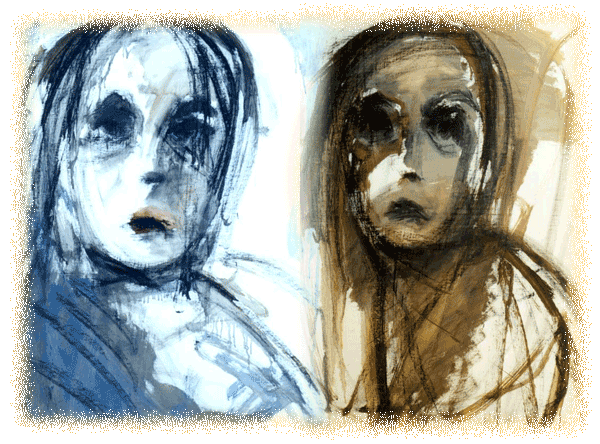Robert J. Lewis


[ Editor's Note: Artist ROBERTO ROMEI ROTONDO was born in Milan, Italy, studied at Academia delle Belle Arti in Florence, and later under Guido Molinari and the sculptor Tino Petronzio. After many successful years of painting in Italy, he now enjoys an international reputation, dividing his time between his studios in Tuscany and Quebec. In Canada his work is on permanent exhibition at Galerie Lamoureux Ritzenhoff, Montréal, Québec. ] "It seemed that the mask imposed on human suffering was the lie of lies and must be torn away." - Andre Malraux. |
 With
all due respect to Vogue and Cosmopolitan, in case you have
forgotten that unhappy women still exist, I refer you to the portraits of Milan-born,
Roberto Romei Rotondo. Taken as a whole, the work would go off the charts if
such a thing as a misery index existed. As a collection of art, it represents
some of the most compelling portraiture I’ve encountered since Giacometti.
I’m still not sure if Rotondo’s procession of miserable women have
been given the day off from Dante’s hell, or if, in the bold and unsparing
manner of a Dostoyevsky, he’s reporting on the reactions of these women
in his relationships with them? Either way, their misery translates into what
I would characterize as the misery of intelligence, that will have no truck
with either pretence or dissimulation. Each portrait is a confession where every
veil has been stripped away, leaving the Madeleine’s I and II, for example,
exposed in the plenitude of the truth of their being -- and light years away
from the womanhood portrayed by Hollywood.
With
all due respect to Vogue and Cosmopolitan, in case you have
forgotten that unhappy women still exist, I refer you to the portraits of Milan-born,
Roberto Romei Rotondo. Taken as a whole, the work would go off the charts if
such a thing as a misery index existed. As a collection of art, it represents
some of the most compelling portraiture I’ve encountered since Giacometti.
I’m still not sure if Rotondo’s procession of miserable women have
been given the day off from Dante’s hell, or if, in the bold and unsparing
manner of a Dostoyevsky, he’s reporting on the reactions of these women
in his relationships with them? Either way, their misery translates into what
I would characterize as the misery of intelligence, that will have no truck
with either pretence or dissimulation. Each portrait is a confession where every
veil has been stripped away, leaving the Madeleine’s I and II, for example,
exposed in the plenitude of the truth of their being -- and light years away
from the womanhood portrayed by Hollywood.
 It
takes no small courage to pursue the truth when that truth must always include
the artist’s response to a world that reveals the magnificence of his
soul as well as the secret torments he would otherwise conceal. My feeling is
that Roberto Rotondo has undergone immense suffering in the act of creation,
in bringing these unhappy but willing women into the world, each representing
a rib shorn from him, a reminder that there is no escaping the metaphysical
consequences of being in the world.
It
takes no small courage to pursue the truth when that truth must always include
the artist’s response to a world that reveals the magnificence of his
soul as well as the secret torments he would otherwise conceal. My feeling is
that Roberto Rotondo has undergone immense suffering in the act of creation,
in bringing these unhappy but willing women into the world, each representing
a rib shorn from him, a reminder that there is no escaping the metaphysical
consequences of being in the world.

But the psychology, or narrative is only half the story; for it is the painterly qualities of the work that set it apart, allowing their effects to gradually grow on and engage the viewer. Employing a liberal and spontaneous brush stroke while avoiding the pitfalls of caricature, the final result belies his technical mastery. In works that may require a month before they are brought to completion, he treats his portraits as if dealing with human flesh, waiting for that spark of life to appear, for the woman to announce her presence and worldly experiences that will have informed her expression. Like life itself, often gray and fuzzy at the edges, where there are few consolations and absolutes, Rotondo's choice of a dominant color, upon closer inspection, discloses the presence of a myriad of colors, where borders dissolve into each other, and foreground and background volumes are equal in value, where subject and object are as inseparable as mixed paint, and aesthetics and metaphysics share the same palette.



Be
as it may that galleries and collectors have shown a decided preference for
the artist’s quite remarkable landscapes, I’m convinced that when
Roberto Romei Rotondo’s story is finally told, (with the help of Bacchus
and tobacco) his portraiture, however unfit for our salons and living rooms,
will stand out as his greatest achievement, and will distinguish him as one
of Canada’s most original and compelling portrait masters.
THE END